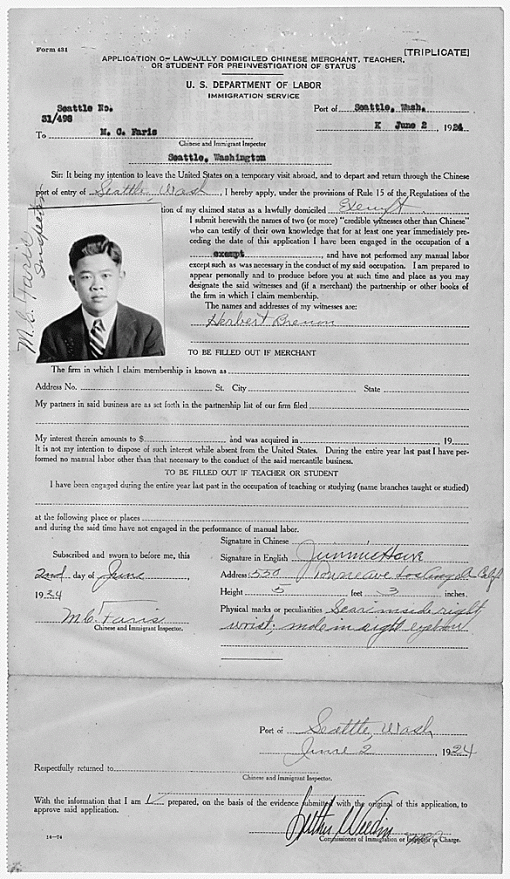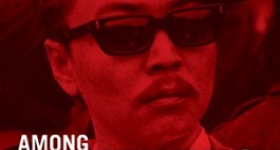James Wong Howe excelled as a cinematographer at a time when anti-immigrant sentiment was at its peak.
This week in 1882, the Chinese Exclusion Act was enacted with the sole purpose of preventing Chinese immigrants from entering the country and becoming US citizens. The Immigration Act of 1924 barred immigration from any Asian country entirely, and also made it difficult for Chinese immigrants and Chinese Americans to leave and re-enter the US. Widespread immigration from Asia would not take place until 1965.
I’m no historian, but I’m going to guess that the 1920s were probably not a super-fun time to be Asian in America. But while the government sought to keep Chinese immigrants out, Hollywood was busy embracing one Chinese American man whose creative genius with the camera would eventually garner no fewer than 10 Academy Award nominations and two wins.
James Wong Howe, also called Jimmie Howe, was born in 1899 in the Canton province of China. His family traveled to the US in 1904, and Howe mainly grew up in Washington.
A number of film festivals will be celebrating his work as a part of APA Heritage month, including a showing of his Oscar-nominated work, The Old Man and the Sea, on Saturday, May 14 in Washington, DC. But this edition of Blast from the Past will take a tiny glimpse at Howe’s life through the lens of federal records rather than a movie camera.
However, keep in mind that this won't be a typical AsAm hero profile. For Asian Americans growing up under the infuriating shadow of immigration acts and anti-miscegenation laws, getting into a profession you loved or wanting to marry someone of a different race required a certain kind of quiet courage and rebelliousness than it does for Asian Americans today.

Documents pulled from the National Archives and Records Administration (NARA) show that, in the same year that the Immigration Act of 1924 was passed, Howe applied for a Laborer’s Return Certificate so he could re-enter the US through the Chinese port of Seattle, WA, after going to Canada to photograph “The Alaskan” for Lasky Studio. A return certificate is one of several types of documents the government used to identify those who were exempt from the Chinese Exclusion Act because they lived in the US before the act was adopted. The return certificate allowed him to re-enter the US after travel abroad.
The application shows an undisguised distrust of the Chinese, but also reveals Howe’s movie industry connections. When asked to provide “credible witnesses other than Chinese,” Howe lists silent film director Herbert Brenon. Brenon would be nominated for an Academy Award for Best Director in 1929. This would be about a year after he became a much sought-after cameraman in Hollywood when he accidentally discovered a method of making an actress’s blue eyes show up well on black and white film.
Also in his NARA files are two testimonies he gave to the US Department of Labor for his Laborer’s Return Certificates: one for 1924 photo shoot in Canada; and one for a 1928 trip to Shanghai, China.
Within the typed testimonies, Howe appears to be polite and articulate, despite a few hiccups during the questioning. For instance, he first gave his birth place as Pasco, WA, which contradicted his mother’s testimony that he was born in China. She herself had been born in San Francisco, CA, but taken back to China as a baby. She had gotten married there before returning to the US with her young family. Howe’s father had a certificate of residence, but that was lost after he died when Howe was a teen. Howe answers honestly that he did not possess any papers showing his right to be and remain in the US, and didn’t even know his true birthplace until he was nearly 25 years old. (Sounds curiously similar to a certain modern day issue, does it not?)
The Chinese Exclusion Act would be repealed in 1943, but California’s anti-miscegenation laws prevented him from marrying novelist Sanora Babb, a white woman, until 1948. They would remain together until his death in 1976.
As an Asian American, I grew up inundated with stories about minorities who have overcome racial adversity and rally for social justice. In the course of my research, I didn’t find anything to suggest that Howe went out of his way to be a champion of Asian American rights. It seems he chose to excel in his profession within the restrictions of the law, not unlike writers who work within rigid poetic confines to produce masterful sonnets.
In the end, it was Howe’s skills behind a camera that made him a renowned cinematographer in the industry. The fact that he was also Chinese American living in a time of strong anti-immigrant sentiment? Aside from a family anecdote of him wearing a large “I Am Chinese” button on his coat to differentiate himself from the anti-Japanese activities during World War II, he didn’t leave any remarks that hinted at activism or desire for social change.
However, I did feel a moment of poignancy when I examined his 1924 return certificate application.
Jimmie Howe, eventual Oscar winner, left the “Signature in Chinese” line blank, signing his name only in English. Under “Physical remarks or peculiarities,” he wrote “Scar inside right wrist; mole in right eyebrow.” He doesn’t point out any features related to his ethnicity.
You can argue that he most likely never learned to write in Chinese, but I’d like to think Howe was also a kind of inadvertent rebel. He worked in a largely white industry, doing so well and making it so big that no one could ignore his abilities because of his ethnicity. In a time where it was not popular to be Chinese, Howe and Sanora were very public with their interracial relationship even though they couldn’t legally be together. Choices that meant something pretty different, back before the role of model minority had been scripted.
Further reading:
Chinese Immigration and the Chinese in the United States
Master DP James Wong Howe / A Relative’s Perspective
James Wong Howe Replies to Comment on Cameramen
[Document Source: Application for preinvestigation of status in order that James Wong Howe might leave the United States and be eligible for return., 06/02/1924. Item from Record Group 85: Records of the Immigration and Naturalization Service, 1787-2004. NARA’s Pacific Alaska Region (Seattle) (NRIAS), 6125 Sand Point Way NE, Seattle, WA, 98115-7999.]










Comments